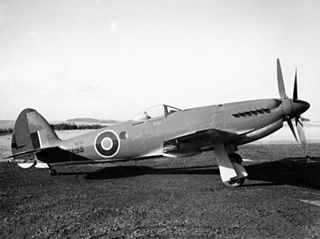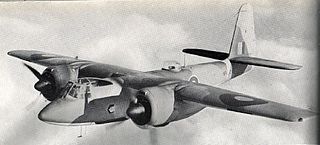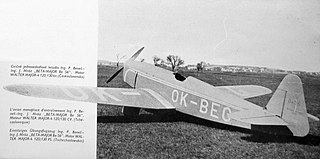
The Heinkel He 116 was an extremely long-range mail plane designed and produced by the German aircraft manufacturer Heinkel.

The Supermarine Seafang was a British Rolls-Royce Griffon–engined fighter aircraft designed by Supermarine to Air Ministry specification N.5/45 for naval use. It was based on the Spiteful, which was a development of Supermarine's Griffon-engined Spitfire aircraft. By that time the Spitfire was a 10-year-old design in a period of rapid technical development in aviation. The Seafang was outmoded by jet aircraft, and only 18 were built.

The Fokker S.13 Universal Trainer was a dual engine propeller aircraft for training purposes designed and manufactured by the former Dutch aircraft manufacturer Fokker. It first flew in 1949, but did not go into production. The prototype was flown a few years before being donated.

The Miles M.33 Monitor was a twin-engined British target tug aircraft designed and built by Miles Aircraft towards the end of the Second World War. Intended for use by the Royal Air Force and the Fleet Air Arm, the aircraft did not enter service with either.

The Airspeed AS.39 Fleet Shadower was a British long-range patrol aircraft design that did not go beyond the prototype stage. A similar aircraft, the General Aircraft Fleet Shadower, was also built to the extent of prototypes. While the concept of a fleet shadower had some promise, the resulting designs were soon overtaken by wartime developments in airborne radar.

The Aero-Flight Streak was an American two-seat light aircraft built in 1946 by Aero-Flight Aircraft Corporation at Buffalo, New York. Advanced for its time, it was of all-metal construction with tricycle undercarriage, and accommodated the pilot and passenger in tandem beneath a sliding, bubble canopy.

The BAT F.K.24 Baboon was a British two-seat training biplane produced by British Aerial Transport Company Limited of London during World War I.

The Caproni Ca.101 was a three-engine Italian airliner which later saw military use as a transport and bomber. It was designed in 1927 and first flown in 1928.

The PWS-21 was a Polish passenger aircraft for 4 passengers, built in PWS factory in 1930, that remained a prototype.

The Macchi MB.308, later Aermacchi MB-308, is a light aircraft produced in Italy in the late 1940s.

The Blohm & Voss Ha 140 was a German multi-purpose seaplane first flown in 1937. It was intended for use as a torpedo bomber or long-range reconnaissance aircraft but did not enter production.

The Siebel Fh 104 Hallore was a small German twin-engined transport, communications and liaison aircraft built by Siebel.
The Bristol Type 109 was a British two-seat long-distance biplane built by the Bristol Aeroplane Company at Filton Aerodrome, England.
The Airdrome Fokker DR-1 is an American amateur-built aircraft, designed and produced by Airdrome Aeroplanes, of Holden, Missouri. The aircraft is supplied as a kit for amateur construction and is available in two versions, a full-sized and a 3/4 scale replica.
The Airdrome Fokker D-VI is an American amateur-built aircraft, designed and produced by Airdrome Aeroplanes, of Holden, Missouri. The aircraft is supplied as a kit for amateur construction.

The Airdrome Fokker D-VII is an American amateur-built aircraft, designed and produced by Airdrome Aeroplanes, of Holden, Missouri. The aircraft is supplied as a kit for amateur construction.

The Airdrome Fokker D-VIII is an American amateur-built aircraft, designed and produced by Airdrome Aeroplanes, of Holden, Missouri. The aircraft is supplied as a kit for amateur construction.
The OFW OK-15 was a 1950s Austrian two-seat light aircraft. Designed by Otto Kauba and built by the Österreichische Flugzeugwerke GmbH (OFW) at Wiener Neustadt, it was the first aircraft to be designed and built in Austria for 20 years.

The IAR-811 was a Romanian trainer aircraft built in the late 1940s. It was the first aircraft designed and built in Romania following the end of the Second World War.

The Beneš-Mráz Be-56 Beta-Major was a single-seat aerobatic advanced trainer manufactured in Czechoslovakia shortly before World War II.

















